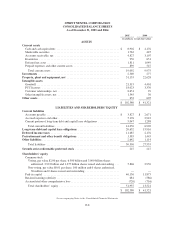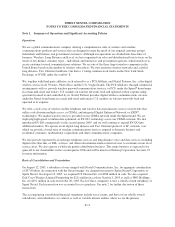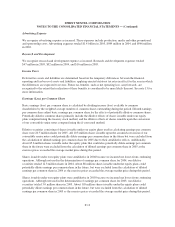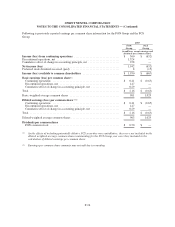Sprint - Nextel 2005 Annual Report Download - page 112
Download and view the complete annual report
Please find page 112 of the 2005 Sprint - Nextel annual report below. You can navigate through the pages in the report by either clicking on the pages listed below, or by using the keyword search tool below to find specific information within the annual report.
SPRINT NEXTEL CORPORATION
NOTES TO THE CONSOLIDATED FINANCIAL STATEMENTS — (Continued)
plant and equipment assets may not be useful for as long as originally anticipated, we depreciate the remaining
book values over the remaining estimated useful lives. In 2004, we extended the depreciable life of certain high-
capacity transmission equipment from eight years to twelve years due to slower anticipated evolution of
technology. This extension in life decreased the 2004 depreciation expense in Long Distance by approximately
$74 million.
Network equipment and software includes switching equipment and cell site towers, base transceiver stations,
other radio frequency equipment, internal use software, metallic cable and wire facilities, digital fiber-optic
cable, conduit, poles, other central office and transport facilities, and transmission-related equipment. Buildings
and improvements principally consists of owned general office facilities, leasehold improvements and retail
stores.
Non-network internal use software, office equipment and other principally consists of furniture, information
technology equipment and vehicles.
Network asset inventory and construction in progress primarily includes materials, transmission and related
equipment, labor, engineering, site development, interest and other costs relating to the construction and
development of our network. Assets under construction are not depreciated until placed into service.
Our gross property, plant and equipment aggregated by business segment was as follows:
December 31,
2005 2004
(in millions)
Wireless ............................................................... $ 31,203 $ 19,376
Long Distance .......................................................... 2,692 2,356
Local ................................................................. 19,784 19,496
Other ................................................................. 2,180 2,334
Gross property, plant and equipment ........................................ $ 55,859 $ 43,562
We review our long-lived assets for impairment whenever events or changes in circumstances indicate that the
carrying amount may not be recoverable. If the total of the expected undiscounted future cash flows is less than
the carrying amount of our assets, a loss, if any, is recognized for the difference between the fair value and
carrying value of the assets. Impairment analyses, when performed, are based on our current business and
technology strategy, our views of growth rates for our business, anticipated future economic and regulatory
conditions and expected technological availability.
Asset Retirement Obligations
In accordance with SFAS No. 143, Accounting for Asset Retirement Obligations, we record an asset retirement
obligation and an associated asset retirement cost when we have a legal obligation in connection with the
retirement of tangible long-lived assets.
Adoption of SFAS No. 143 on January 1, 2003, affected the cost of removal historically recorded by the Local
segment. Consistent with regulatory requirements and industry practice, our Local segment historically accrued
costs of removal in its depreciation reserves. These costs of removal do not meet the SFAS No. 143 definition of
an asset retirement obligation. Upon adoption of SFAS No. 143, we recorded a reduction in our historical
depreciation reserves of approximately $420 million to remove the accumulated excess cost of removal, resulting
in a cumulative effect of change in accounting principle credit, net of tax, in the accompanying consolidated
statements of operations of $258 million.
F-17
























